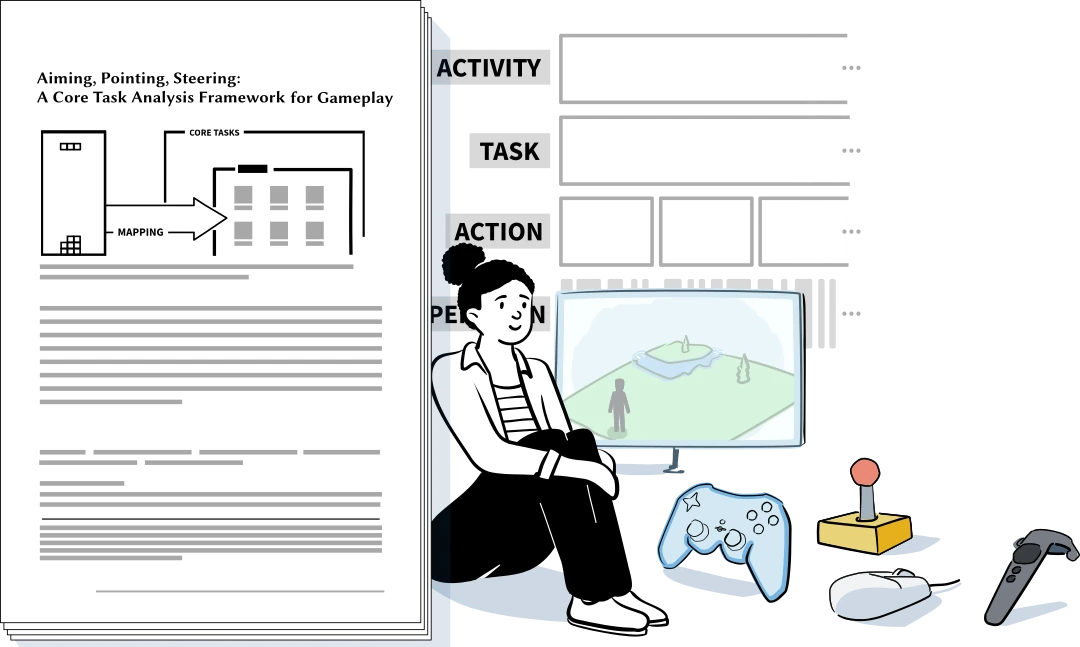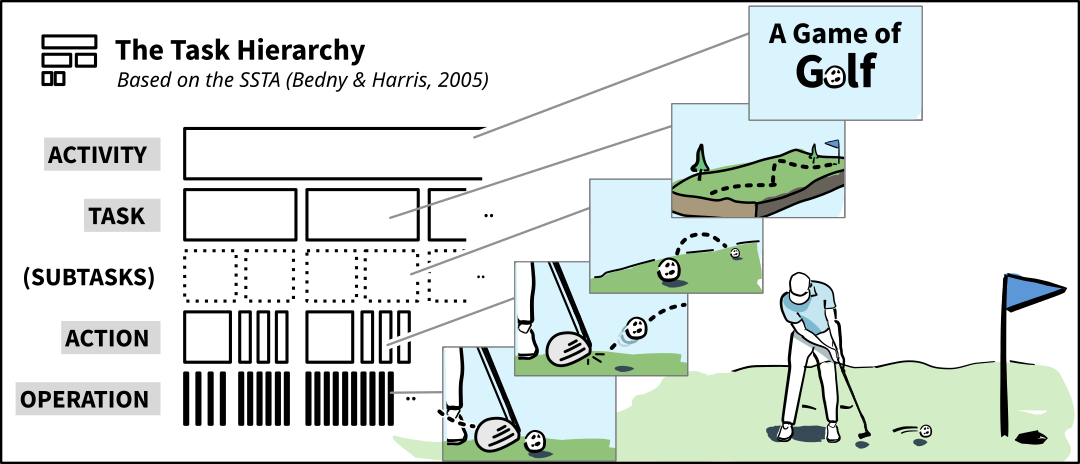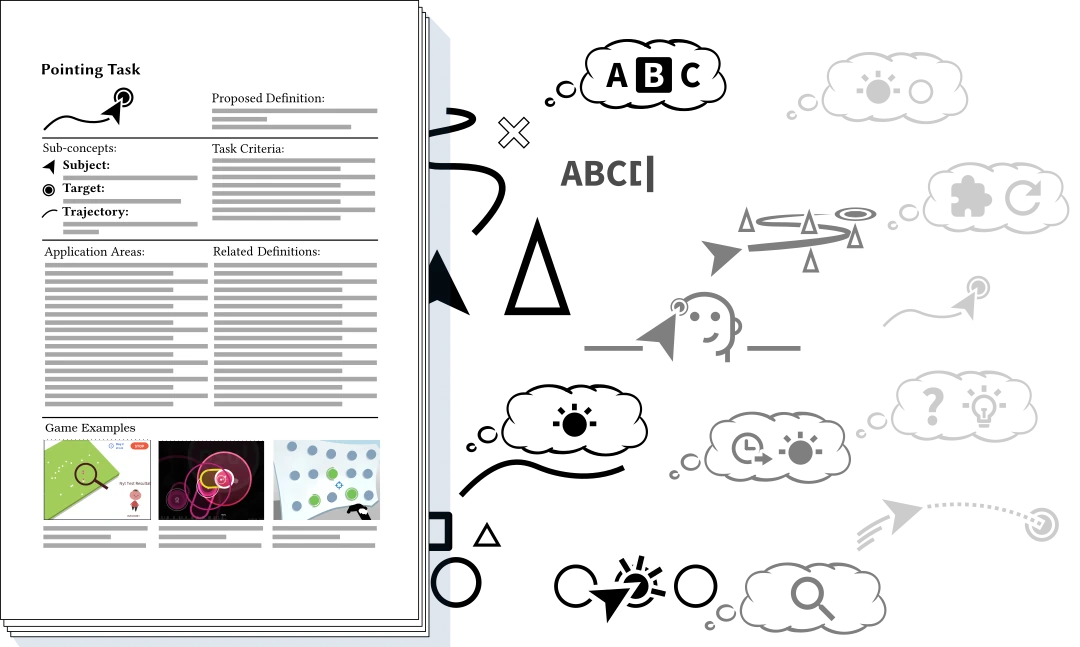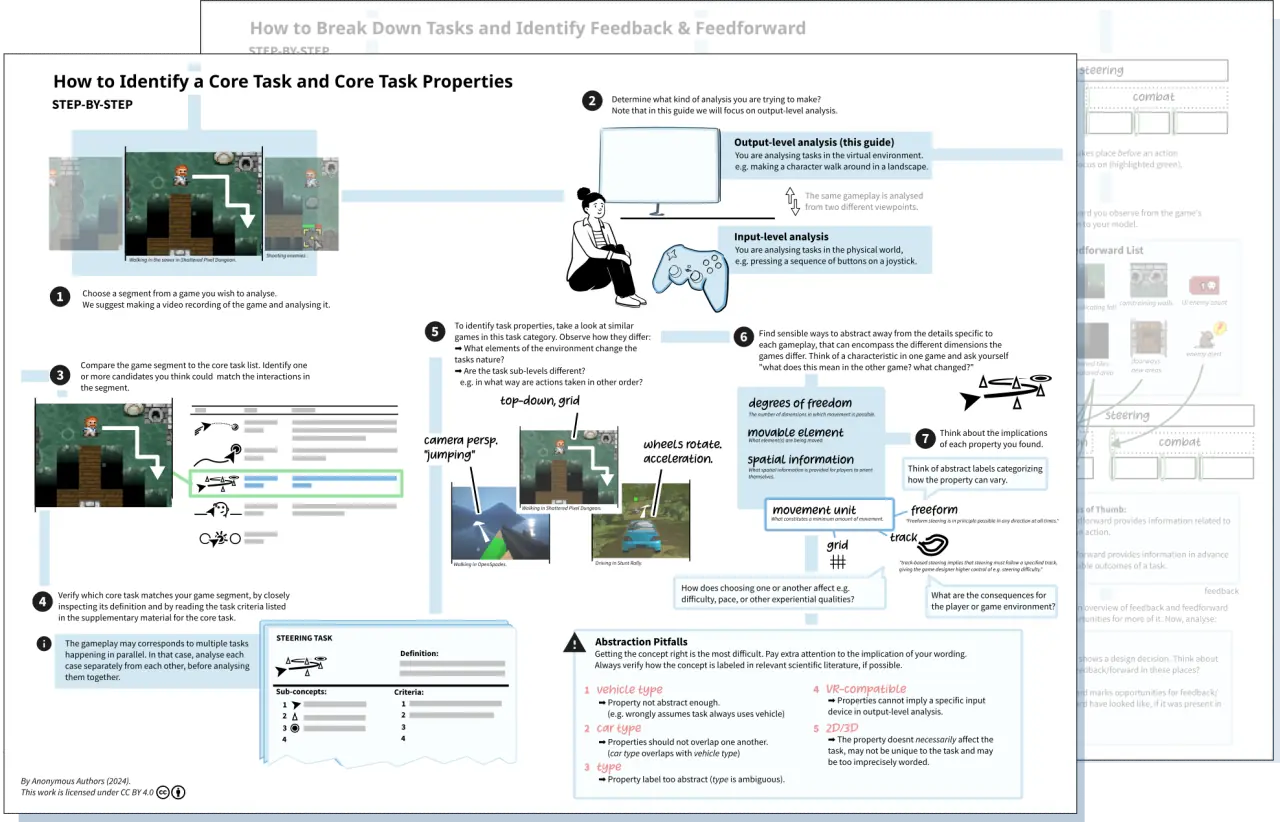Aiming, Pointing, Steering: A Core Task Analysis Framework for Gameplay is a design framework which facilitates analysis of gameplay as tasks. It was presented by at CHI PLAY 2024 and published in the Proceedings of ACM Human Computer Interactions Volume 8. The paper and materials on this website are licensed as CC-BY 4.0.
Cites as:
Bastian Ilsø Hougaard and Hendrik Knoche. 2024. Aiming, Pointing, Steering: A Core Task Analysis Framework
for Gameplay. Proc. ACM Hum.-Comput. Interact. 8, CHI PLAY, Article 292 (October 2024), 49 pages.
https://doi.org/10.1145/3677057
Task Hierarchy Explained Through Golf
Aiming, Pointing, Steering bridges the Systemic-Structural Theory of Activity (SSTA) to goals and mechanics in game literature. To exemplify each level (activity, task, action, and operation), we examine an imagined digital golf game. The activity level describes playing one game of golf. The task level describes completing one single hole (an 18 hole golf game consists of 18 tasks). Sub-task levels describe the intermediary golf shots that the player chooses to take to solve the task. The action level describe the actions the player consciously takes to complete each golf shot - adjusting the direction, their knees, and making the swing (multiple swings if they miss the ball). The lowest operation level describes subconscious events performed by players within each action - for example the timing and tension of muscles during the swing itself. The figure above is licensed under a CC-BY 4.0 international license.
Cite this picture as:
B. I. Hougaard and H. Knoche. 2024. Task hierarchy explained through golf [Photograph]. Aiming Pointing Steering Website. CC-BY 4.0. Retrieved from
https://gametasks.create.aau.dk/#ssta
Task Appendix
The full appendix of core tasks, provided as stand-alone for convenience. Covers Aiming, Pointing, Steering, Drawing, Activation, Typing, Selection, Configuration, Memory, Spatial Memory, Detection, Discrimination, Prediction, and Search tasks.
Step-by-Step Guides
We provide practical printable A3 step-by-step guides on identifying tasks and feedback in tasks, intended as game design teaching material. The exemplified games are open source: Shattered Pixel Dungeon, Stunt Rally, and OpenSpades.
Video with Game Analysis Examples
Audio Transcription of Video - 218 words
We propose a design framework containing four tools which map games to core tasks to uncover their game design landscape. Core tasks are abstractions of the interaction work players must do within a game's interaction loop. In systemic theory of activity, activities consists of tasks like the task to steer a block to a spot in Tetris. tasks consists of conscious actions like the action to move a block a single step left or right. and actions consist of subconscious operations. like the continuous perception of the block's movements. Our contribution extends the core task list by previous work and establishes a design framework of games for game design and scientific use. Core task identification maps a game's gameplay to a core task family. Core task sequencing, describes temporal frequency, like how and when a task appears in the activity. Core task composition breaks a core task into its actions and operations. Finally, core task examination brings to surface goals, feedback and feedforward design opportunities. We invite others to use this framework, to help systematically unfold gameplay, invent new abstract tasks and discover their properties. The framework is a complementary inventory compatible to existing game and feedback terminology in gameplay. Going forward, we seek to validate the merits of our framework in practice as a game design lens.
Presentation at CHI PLAY '24
Audio Transcription of Presentation - 1200 words
Hi everyone, my name is Bastian. "Aiming, Pointing, Steering" is a game design theoretical paper that I have written with Hendrik Knoche. This QR code takes you to our website where you can find all materials from this talk. Our work reviewed some fundamental building blocks we call 'tasks' which turn out to be useful terminology to describe game interactions structurally. We all know games are powerful as vehicles to get people to behave in a certain way. yet games are complex to scientifically design, study and employ as solutions to our real-world problems. Because games are complex mediums, we also often let games surface representation slip into our language which obscures what underyling interactions we deal with. Just think of genres namings like 'racing games' or 'first person shooter' for example. Many games are studied described and published without this abstraction level and that makes it difficult for ourselves to synthesize our work. When we think of games we popularly describe them from their representation. For example, we might describe this game as a game where a character has a goal of walking across the river. Underneath that representation, games have an underlying system we can describe in abstract terms. Existing work within game ontology differentiates between representational language and structural language. For example, in abstract terminology crossing the river can be considered a goal of reaching something, and the ability to walk can be considered a movement mechanic. All these concepts are available to describe the game in isolation, but what about game interactions? By 'game interactions', we refer to the actual gameplay and the moment-to-moment activity of playing the games. These activities all look so different, but actually they also have a lot of things in common. From an interaction perspective, for example, the first person shooter here and Tetris have some things in common which might not be obvious from the surface. You can for example think of both of them as involving some kind of steering. We can think of game interactions as the interaction work a given user performs with a game. The user plays the game through some input modality, and receives the experience through the output modality. So what's needed here is a language that transcends beyond specific input modality, and beyond the games representation. This is one of the complexities that games just have as mediums. To describe game interactions we built upon the notion of tasks. Tasks represent a classic scientific concept in HCI but we dont really talk about them in games or as tools for game design. Tasks describe sequences of actions, They represent the interaction work people do, They have goals which explain why people people do them, and you can think of them as being embedded into the experienced game world. If you are interested in the origins of tasks, read more in our full paper. We describe this situation using task hierarchies then. Task hierarchies are timelines that show how tasks, subtasks and actions unfold over time. Our contribution consists of basic task building blocks, and a framework that demonstrate how to model and analyze gameplay as tasks. The basic building blocks are also known as 'core tasks' in game scholarship. They are basic tasks that Refai's work on external assistance techniques initially defined. Our work refines and extends Refai's list and animates them. You can think of core tasks as high-level categories that become starting points for classification. To unfold analysis further we created a framework. It describes four tools, which we demonstrate for four scientific application areas. With this we can now create models of games' gameplay. 'Identification' classifies a specific segment of gameplay to a task. This goes beyond just mapping a game to a core task. Here on the left side is a simple game called 'Whack-a-mole'. We can describe the interactions in this game on different levels of abstraction. At the concrete level we use representation language, while at the abstract level this is where you find the basic task classification. The key is to identify the right design characteristic that describe this particular type of pointing. 'Sequencing' relates to the frequency and duration of the tasks. like looking at how melodies repeat in music. 'Composition' refers to how the task is broken down into actions and operations, and the last tool 'Examination' refers to the process of discovering goals, feedback and feedforward opportunities. It should be clear that these models can help us synthesize previous work but what can we use these tools for? How does it help game design? With the four tools in mind, I want to help us imagine what these tools will let us do. So first of all it enables us to create conceptual models at our own chosen range of detail. At the most basic level we can perform simple task classification with the 'Identification' tool. If you want to go one step further from there you can decompose it into a conceptual task hierarchy. If you want you can also add more precise subclassification of your task. And at the most detailed level, we can create real-time models of the gameplay. The second use case is creating design landscapes which you can use to navigate where you want to go with your gameplay design. Imagine you create a map of games. Each dot on the map is a game grouped by similarity. For example, this over here could be a minigolf game. We can now use our core tasks to draw the larger boundaries and within those boundaries we can start identifying subclassifications that might define new subcategories of core tasks. which leads me to the next application: identifying design properties. Design properties are the things that make each game's implementation of its task unique. We exemplfiy design properties for pointing tasks in our paper. Finally, I also find the framework a nice provocative design tool, that raises new questions in my game design process. What does Counter-Strike and Tetris have in common? What if racing games didn't use steering? When does aiming become pointing? So these are the key points: We can reduce complexity by considering games beyond their surface. And we can think of game interactions in terms of tasks. We can organize game interactions into some distinct categories. We can use this as a design tools to think of interactions outside the box. We can use this for rigorous analysis. And its designed to compliment other frameworks and existing game ontology. We would like to thank all authors of previous work that made this framework possible. We want to thank the people who make great an freely available games And we want to thank our student, our collaborators, our reviewers and Susanne, Scott and Mitchell for sharing their viewpoints on this subject. We created a website where you can explore the resources on the topic including an animated video to explain the concepts and step-by-step guides. Our appendix aim to provide an overview of each core task which you can use as a starting point for further research. Do feel free to get in touch with us on mail or social media if you have questions on this topic.
Interactive Slideshow
Show Interactive Slideshow
Visual Assets
We provide the iconography and animations below as downloads below for convenience. Feel free to use them in your analysis.
Get in touch:
Feel free to reach out if you found the concepts and material useful, have suggestions or questions.
Bastian I. Hougaard
biho@create.aau.dk
bastianilso@mastodon.art
Bastian I. Hougaard, PhD Fellow
Hendrik Knoche
hk@create.aau.dk
Hendrik Knoche, Assoc. Professor
Best regards,
Bastian and Hendrik.



